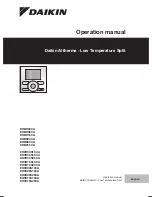
KGL Operating Manual – VS 3010 BS
2018-07-02
/
57 178
The setpoint for the temperature regulation (tc-Z2Soll) for the cascade controller is determined according to
the following function:
tc-Z2Soll = toZ1 + tcZ2-toZ1 Diff
The tcZ2-toZ1 offset can be configured via the parameter “tcZ2-toZ1 Diff” (menu 3-2-3). The tc-Z2 setpoint,
calculated according to the setpoint shift, is restricted by an upper and lower tc-Z2 setpoint threshold. The
thresholds can be configured using the parameters ”tcZ2 Max” and ”tcZ2 Min” (menu 3-2-3) In the event of the
failure of the po-Z1 transducer, the average value of ”tcZ2 Max” and ”tcZ2 Min” is used for tc-Z2Soll.
If the to-Z1 actual value changes, the tc-Z2 setpoint is smoothed using a ramp function and updated. The
maximum rate of change for the tc-Z2 setpoint can be configured via the parameter “tcZ2-Rampe/m” (menu 3-
2-3). This prevents rapid setpoint changes.
4.6.1.5 Continuous superheat regulation using the evaporating temperature Z1
Superheat control operates in parallel with temperature control. If necessary, it can be regulated to the
specified superheat setpoint. Superheat control has two operating modes that can be selected via the
correction offset to (parameter corr.off. to, menu 3-2-3):
Temperature operating mode - temperature control: (parameter Korr.off. to = “---”)
Calculation of the superheat actual value from the temperature measurement at the cascade heat exchanger
input (temperature sensor R5.1) and at the cascade heat exchanger output (temperature sensor R6.1).
Temperature-pressure regulation operating mode: (parameter Korr.off.to not equal to “---“)
Calculation of the difference between the evaporation temperature of the Z1 circuit (t0-Z1+Korr.off.to)
corrected by the offset (parameter Korr.off. to, menu 3-2-3 ) and the temperature at the cascade heat
exchanger output (temperature sensor R6.1). The adjustable offset value Korr.off. to here corrects the
measured to-Z1 actual value by the possible pressure drop in the suction line and the associated deviations
between the measuring point for the suction gas pressure on the compressor and the suction gas pressure at
the cascade heat exchanger input. In the case of any Z1 measuring loop error, the superheat is calculated
from the temperature difference of R5.1 and R6.1 (temperature-temperature control).
As an additional protection function, the expansion valve is completely closed if a critical minimum superheat is
undercut. The closing of the valve due to undercutting the minimum superheat is performed within a
configurable closing time. A message “emerg.cut-out SH” is output. The message priority can be parametrised.
4.6.1.6 Valve control – output of the opening degree
One or two continuous control valves that are controlled by a 0…10 Volt signal is/are used as actuator for the
cascade regulation. In the tandem operating mode (parameter ”Tandembetr.” in menu 3-2-3), it can be set
whether one or two expansion valves are used. The enabling of the expansion valves depends on the selected
operating mode.
If two valves are used, the input signal is switched to both valves in parallel. The opening degree of the control
valves (0% ... 100%), according to the output of the PID controller (temperature / superheat controller),
corresponds to an input signal of 0 V to 10 V. The valve actuation is performed via the analogue output 4
(terminals 63/64) of the pack controller. In addition, the valves are enabled and disabled via the relay outputs.
4.6.1.7 Output of the opening degree for single-valve operation
Valve enable with deactivated tandem operation (parameter ”Tandembetr.” =”NO”, menu 3-2-3).
If tandem operation is not active, valve 1 is enabled as soon as the PID controller operating independently of
the enable function has calculated an opening degree greater than zero. If the opening degree is equal to zero,
the enable is withdrawn. In order to prevent excessively high relay switching frequency, the enable and the
disable signals remain present for at least 35 seconds.
















































